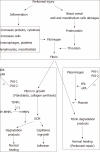Pathophysiology and prevention of postoperative peritoneal adhesions
- PMID: 22147959
- PMCID: PMC3225091
- DOI: 10.3748/wjg.v17.i41.4545
Pathophysiology and prevention of postoperative peritoneal adhesions
Abstract
Peritoneal adhesions represent an important clinical challenge in gastrointestinal surgery. Peritoneal adhesions are a consequence of peritoneal irritation by infection or surgical trauma, and may be considered as the pathological part of healing following any peritoneal injury, particularly due to abdominal surgery. The balance between fibrin deposition and degradation is critical in determining normal peritoneal healing or adhesion formation. Postoperative peritoneal adhesions are a major cause of morbidity resulting in multiple complications, many of which may manifest several years after the initial surgical procedure. In addition to acute small bowel obstruction, peritoneal adhesions may cause pelvic or abdominal pain, and infertility. In this paper, the authors reviewed the epidemiology, pathogenesis and various prevention strategies of adhesion formation, using Medline and PubMed search. Several preventive agents against postoperative peritoneal adhesions have been investigated. Their role aims in activating fibrinolysis, hampering coagulation, diminishing the inflammatory response, inhibiting collagen synthesis or creating a barrier between adjacent wound surfaces. Their results are encouraging but most of them are contradictory and achieved mostly in animal model. Until additional findings from future clinical researches, only a meticulous surgery can be recommended to reduce unnecessary morbidity and mortality rates from these untoward effects of surgery. In the current state of knowledge, pre-clinical or clinical studies are still necessary to evaluate the effectiveness of the several proposed prevention strategies of postoperative peritoneal adhesions.
Keywords: Abdominal pain; Abdominal surgery; Complication; Laparoscopy; Occlusion.
Figures
Similar articles
-
Pathophysiology of adhesions.Chirurgia (Bucur). 2014 May-Jun;109(3):293-8. Chirurgia (Bucur). 2014. PMID: 24956331
-
Peritoneal adhesions: etiology, pathophysiology, and clinical significance. Recent advances in prevention and management.Dig Surg. 2001;18(4):260-73. doi: 10.1159/000050149. Dig Surg. 2001. PMID: 11528133 Review.
-
Adhesive small bowel obstruction: epidemiology, biology and prevention.Can J Surg. 2007 Aug;50(4):291-300. Can J Surg. 2007. PMID: 17897517 Free PMC article. Review.
-
[Postoperative peritoneal adhesions].Ugeskr Laeger. 2008 Oct 13;170(42):3321-4. Ugeskr Laeger. 2008. PMID: 18940167 Danish.
-
Biochemical events in peritoneal tissue repair.Eur J Surg Suppl. 1997;(577):10-6. Eur J Surg Suppl. 1997. PMID: 9076447 Review.
Cited by
-
Inhibition of cyclooxygenase-2 prevents intra-abdominal adhesions by decreasing activity of peritoneal fibroblasts.Drug Des Devel Ther. 2015 Jun 15;9:3083-98. doi: 10.2147/DDDT.S80221. eCollection 2015. Drug Des Devel Ther. 2015. PMID: 26109851 Free PMC article.
-
Outcomes of adhesion barriers in gynecologic surgeries: A retrospective study at a medical center.Medicine (Baltimore). 2019 Dec;98(50):e18391. doi: 10.1097/MD.0000000000018391. Medicine (Baltimore). 2019. PMID: 31852155 Free PMC article.
-
Inherited genetic predispositions in F13A1 and F13B genes predict abdominal adhesion formation: identification of gender prognostic indicators.Sci Rep. 2018 Nov 16;8(1):16916. doi: 10.1038/s41598-018-35185-x. Sci Rep. 2018. PMID: 30446716 Free PMC article.
-
Extensive adhesion formation in a total knee replacement in the setting of a gastrointestinal stromal tumor: A case report.World J Orthop. 2022 May 18;13(5):538-543. doi: 10.5312/wjo.v13.i5.538. eCollection 2022 May 18. World J Orthop. 2022. PMID: 35633745 Free PMC article.
-
The Improvement of Laparoscopic Surgical Skills Obtained by Gynecologists after Ten Years of Clinical Training Can Reduce Peritoneal Adhesion Formation during Laparoscopic Myomectomy: A Retrospective Cohort Study.Biomed Res Int. 2017;2017:9068647. doi: 10.1155/2017/9068647. Epub 2017 Dec 19. Biomed Res Int. 2017. PMID: 29410967 Free PMC article.
References
-
- Parker MC. Epidemiology of adhesions: the burden. Hosp Med. 2004;65:330–336. - PubMed
-
- Boland GM, Weigel RJ. Formation and prevention of postoperative abdominal adhesions. J Surg Res. 2006;132:3–12. - PubMed
-
- Schnüriger B, Barmparas G, Branco BC, Lustenberger T, Inaba K, Demetriades D. Prevention of postoperative peritoneal adhesions: a review of the literature. Am J Surg. 2011;201:111–121. - PubMed
-
- Diamond MP, Freeman ML. Clinical implications of postsurgical adhesions. Hum Reprod Update. 2001;7:567–576. - PubMed
-
- Ellis H. The clinical significance of adhesions: focus on intestinal obstruction. Eur J Surg Suppl. 1997;(577):5–9. - PubMed
Publication types
MeSH terms
LinkOut - more resources
Full Text Sources
Other Literature Sources
Medical


